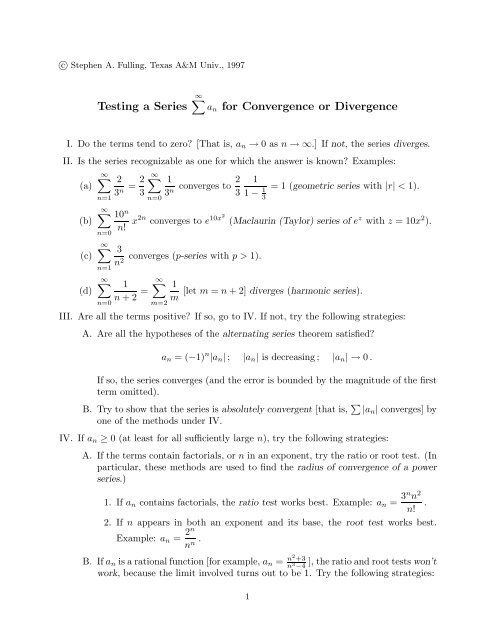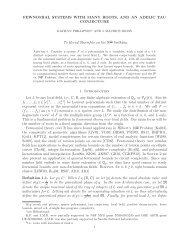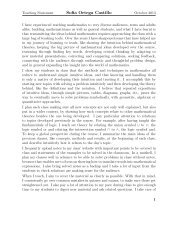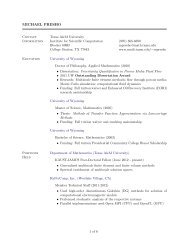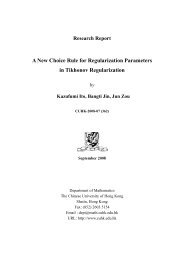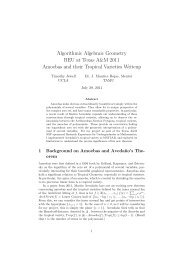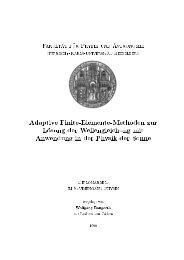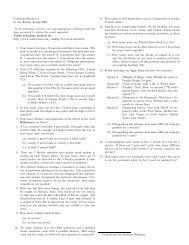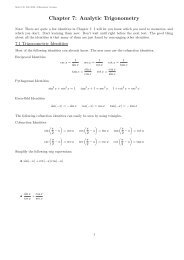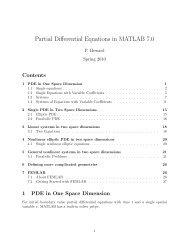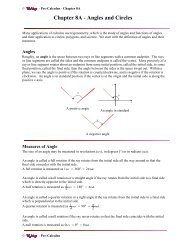Testing a Series an for Convergence or Divergence
Testing a Series an for Convergence or Divergence
Testing a Series an for Convergence or Divergence
Create successful ePaper yourself
Turn your PDF publications into a flip-book with our unique Google optimized e-Paper software.
c○ Stephen A. Fulling, Texas A&M Univ., 1997<br />
<strong>Testing</strong> a <strong>Series</strong><br />
∞ <strong>an</strong> <strong>f<strong>or</strong></strong> <strong>Convergence</strong> <strong>or</strong> <strong>Divergence</strong><br />
I. Do the terms tend to zero? [That is, <strong>an</strong> → 0asn→∞.] If not, the series diverges.<br />
II. Is the series recognizable as one <strong>f<strong>or</strong></strong> which the <strong>an</strong>swer is known? Examples:<br />
(a)<br />
∞<br />
∞ 2 2 1<br />
2<br />
= converges to<br />
3n 3 3n 3<br />
=1(geometric series with |r| < 1).<br />
(b)<br />
(c)<br />
(d)<br />
n=1<br />
∞<br />
n=0<br />
∞<br />
n=1<br />
∞<br />
n=0<br />
n=0<br />
10 n<br />
n! x2n converges to e 10x2<br />
1<br />
1 − 1<br />
3<br />
3<br />
converges (p-series with p>1).<br />
n2 1<br />
n +2 =<br />
∞<br />
m=2<br />
1<br />
m<br />
(Maclaurin (Tayl<strong>or</strong>) series of e z with z =10x 2 ).<br />
[let m = n +2]diverges (harmonic series).<br />
III. Are all the terms positive? If so, go to IV. If not, try the following strategies:<br />
A. Are all the hypotheses of the alternating series the<strong>or</strong>em satisfied?<br />
<strong>an</strong> =(−1) n |<strong>an</strong>| ; |<strong>an</strong>| is decreasing ; |<strong>an</strong>| →0.<br />
If so, the series converges (<strong>an</strong>d the err<strong>or</strong> is bounded by the magnitude of the first<br />
term omitted).<br />
B. Try to show that the series is absolutely convergent [that is, |<strong>an</strong>| converges] by<br />
one of the methods under IV.<br />
IV. If <strong>an</strong> ≥ 0 (at least <strong>f<strong>or</strong></strong> all sufficiently large n), try the following strategies:<br />
A. If the terms contain fact<strong>or</strong>ials, <strong>or</strong> n in <strong>an</strong> exponent, try the ratio <strong>or</strong> root test. (In<br />
particular, these methods are used to find the radius of convergence of a power<br />
series.)<br />
.<br />
n!<br />
2. If n appears in both <strong>an</strong> exponent <strong>an</strong>d its base, the root test w<strong>or</strong>ks best.<br />
Example: <strong>an</strong> = 2n<br />
.<br />
nn 1. If <strong>an</strong> contains fact<strong>or</strong>ials, the ratio test w<strong>or</strong>ks best. Example: <strong>an</strong> = 3n n 2<br />
B. If <strong>an</strong> is a rational function [<strong>f<strong>or</strong></strong> example, <strong>an</strong> = n2 +3<br />
n3−4 ], the ratio <strong>an</strong>d root tests won’t<br />
w<strong>or</strong>k, because the limit involved turns out to be 1. Try the following strategies:<br />
1
1. Use the comparison test <strong>or</strong> limit comparison test to replace the series by one<br />
<strong>f<strong>or</strong></strong> which you know the <strong>an</strong>swer (see II) <strong>or</strong> c<strong>an</strong> find the <strong>an</strong>swer by the integral<br />
test (see below). In choosing a comparison series bn , keep (at least as a<br />
first step) from each fact<strong>or</strong> in <strong>an</strong> the term that grows fastest as n →∞.<br />
Examples:<br />
(a) If <strong>an</strong> = 1<br />
n2 +1 , take bn = 1<br />
n2 . Since <strong>an</strong>bn.Further-<br />
m<strong>or</strong>e, bn ≥ cn ,wherecn= 1<br />
n , <strong>an</strong>d the harmonic series cn diverges.<br />
There<strong>f<strong>or</strong></strong>e, <strong>an</strong> diverges, bythecomparison test. Alternatively, try<br />
approaches infinity, <strong>an</strong>d<br />
the harmonic series diverges, so <strong>an</strong> diverges.<br />
the limit comparison test: <strong>an</strong>/cn = √ n n<br />
n− 1<br />
2<br />
(c) The signs of the const<strong>an</strong>t terms in the two previous examples were chosen<br />
to make the comparison test easy to apply. F<strong>or</strong> <strong>an</strong> = 1<br />
n2−1 <strong>or</strong> <strong>an</strong> = √ n<br />
n+ 1 ,<br />
2<br />
a suitable comparison series, with the inequalities running in the right<br />
direction, is not so obvious; there<strong>f<strong>or</strong></strong>e, the limit comparison test is m<strong>or</strong>e<br />
convenient in those cases.<br />
(d) If <strong>an</strong> = (2 + cosn)/n 2 , neither term in the numerat<strong>or</strong> dominates as<br />
n →∞, so the limit comparison test is hard to use. But <strong>an</strong> ≤ bn =3/n 2 ,<br />
so the comparison test shows that <strong>an</strong> converges.<br />
2. Use the integral test if <strong>an</strong> <br />
= f(n), where f(x) ispositive <strong>an</strong>d decreasing <strong>an</strong>d<br />
∞<br />
1 f(x) dx c<strong>an</strong> be evaluated. Example:<br />
a<br />
ln x<br />
dx<br />
xp 1<br />
c<strong>an</strong> be evaluated by the substitution u =lnx. (This integr<strong>an</strong>d isn’t decreasing<br />
at first, but it is <strong>f<strong>or</strong></strong> sufficiently large x, which is all that matters.) The<br />
integral converges if <strong>an</strong>d only if p>1, so<br />
∞<br />
n=1<br />
converges <strong>or</strong> diverges just like a p-series without the logarithmic fact<strong>or</strong>. (This<br />
conclusion c<strong>an</strong> also be reached by comparison <strong>or</strong> limit comparison arguments.)<br />
2<br />
ln n<br />
n p


